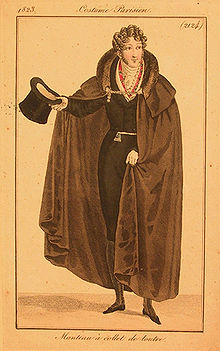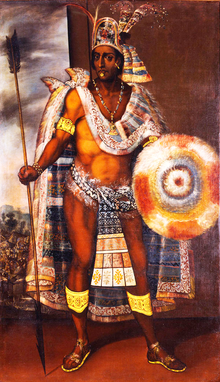Clip Art of a Girl Hidden by a Ckloak

Evening cloak or manteau, from Costume Parisien, 1823

A cloak is a type of loose garment worn over clothing, mostly but non always as outerwear for outdoor wear, serving the aforementioned purpose as an overcoat, protecting the wearer from the weather condition. It may course part of a uniform.[i] Cloaks have been and are worn in countless societies. Over time cloak designs have been changed to friction match mode and available textiles.[ii]
Cloaks generally fasten at the neck or over the shoulder, vary in length, from hip all the way down to the ankle, mid-calf existence the normal length. They may have an attached hood and may cover and fasten down the front, in which instance they have holes or slits for the easily to pass through. However, cloaks are almost always sleeveless.
Etymology [edit]
The word cloak comes from Erstwhile Due north French cloque (Onetime French cloche, cloke) meaning "travelling cloak", from Medieval Latin clocca "travelers' greatcoat," literally "a bong," so chosen from the garment'south bell-like shape. Thus the word is related to the word clock.[iii]
History [edit]
Ancient Greeks and Romans were known to article of clothing cloaks. Greek men and women wore the himation, from the Archaic through the Hellenistic periods (c. 750-30 BC).[4] Romans would later wear the Greek-styled cloak, the pallium. The pallium was quadrangular, shaped similar a square,[v] and sat on the shoulders, not unlike the himation.
Romans of the Democracy would habiliment the toga as a formal display of their citizenship. It was denied to foreigners[vi] and was worn past magistrates on all occasions as a badge of office. The toga was claimed to have originated with Numa Pompilius, the second king of Rome.[seven]
Powerful noblemen and elite warriors of the Aztec Empire would clothing a tilmàtli; a Mesoamerican cloak/cape used as a symbol of their upper status. Material and clothing was of utmost importance for the Aztecs. The more elaborate and colorful tilmàtlis were strictly reserved for elite high priests, emperors; and the Eagle warriors as well as the Jaguar knights.[eight]
Opera cloak [edit]
In full evening dress in the Western countries, ladies and gentlemen oft utilise the cloak as a style statement, or to protect the fine fabrics of evening wear from the elements, especially where a coat would vanquish or hide the garment. Opera cloaks are made of quality materials such as wool or cashmere, velvet and satin.
Ladies may wearable a long (over the shoulders or to ankles) cloak usually called a cape, or a total-length cloak. Gentlemen habiliment an ankle-length or full-length cloak. Formal cloaks often take expensive, colored linings and trimmings such as silk, satin, velvet and fur.
The term was the title of a 1942 operatic comedy.[9]
In literature and the arts [edit]


According to the King James Version of the Bible, Matthew recorded Jesus of Galilee saying in Matthew 5:40: "And if any man will sue thee at the law, and take abroad thy coat, allow him accept thy cloke also." The King James Version of the Bible has the words recorded a trivial differently in Luke 6:29: "...and him that taketh away thy cloke, forbid non to take thy coat too."
Cloaks are a staple garment in the fantasy genre due to the popularity of medieval settings, although fantasy cloak designs ordinarily have more than resemblance to 18th or 19th-century cloaks rather than medieval ones.[ citation needed ] They are as well usually associated with witches, wizards, and vampires; the best-known stage version of Dracula, which first made actor Bela Lugosi prominent, featured him wearing it so that his exit through a trap door concealed on the stage could seem sudden. When Lugosi reprised his role equally Dracula for the 1931 Universal Studios movement picture version of the play, he retained the cloak equally part of his outfit, which fabricated such a potent impression that cloaks came to be equated with Count Dracula in nearly all non-historical media depictions of him.
Fantasy cloaks are frequently magical. For example, they may grant the person wearing it invisibility as in the Harry Potter series by J. K. Rowling. A similar sort of garment is worn by the members of the Fellowship of the Ring in The Lord of the Rings past J. R. R. Tolkien, although instead of granting complete invisibility, the Elf-made cloaks simply appear to shift betwixt any natural color (e.k. light-green, gray, dark-brown) to aid the wearer to blend in with his or her surroundings. In the Marvel comic book stories and in the Marvel Cinematic Universe, the sorcerer Doc Strange is associated with a magical Cloak of Levitation, which not only enables its wearer to levitate, just has other mystical abilities every bit well. Medico Strange also uses it every bit a weapon. Alternatively, cloaks in fantasy may nullify magical projectiles, as the "cloak of magic resistance" in NetHack.
Metaphor [edit]
Figuratively, a cloak may be anything that disguises or conceals something. In many science fiction franchises, such every bit Star Trek, there are cloaking devices, which provide a way to avoid detection by making objects appear invisible. A existent device, albeit of express capability, was demonstrated in 2006.[10]
Considering they continue a person hidden and conceal a weapon, the phrase cloak and dagger has come up to refer to espionage[eleven] and secretive crimes: information technology suggests murder from hidden sources. "Cloak and dagger" stories are thus mystery, detective, and crime stories of this. The vigilante duo of Curiosity comics Cloak and Dagger[12] is a reference to this.
See besides [edit]
| | Wikimedia Commons has media related to Cloaks. |
- Cape
- Chlamys, the ancient and Byzantine Greek cloak
- Cloaking device
- Mantle (clothing)
- Witzchoura
- Tilmàtli
- Poncho
- Robe
- Serape
- Shawl
- Shroud
- Stole
- Veil
- Kinsale cloak
- Fibula (brooch), a brooch or pin for fastening garments, such as cloaks, typically at the correct shoulder
- Wrap (clothing)
- Spanish cloak
References [edit]
- ^ Bernadine Morris (March 31, 1981). "Italian fashion's success: a fresh point of view". The New York Times.
a simple wrap .. extra layer of protection from the elements
- ^ Bess Liebenson (February 24, 1991). "Changing Shapes of Dress: Picayune for Men, Lots for Women". The New York Times.
- ^ "cloak - Origin and pregnant of cloak by Online Etymology Dictionary". www.etymonline.com.
- ^ "Himation - clothing".
- ^ Tertullian, De Pallio, I
- ^ Suetonius, Divus Claudius, 15
- ^ William Smith, LLD; William Wayte; Thou. Due east. Marindin, eds. (1890). "Toga". A Dictionary of Greek and Roman Antiquities. London: John Murray.
- ^ "Ancient Aztec clothing". www.aztec-history.com . Retrieved 18 April 2021.
- ^ Olin Downes (Nov 4, 1942). "Double Bill Given past the New Opera: Damrosch'due south 'The Opera Cloak' Offered equally Part of Plan at Broadway Theatre". The New York Times. p. 26.
Damrosch's operatic comedy, "The Opera Cloak"
- ^ John Schwartz (Oct xx, 2006). "Scientists Take Step Toward Invisibility". The New York Times.
- ^ Philip Taubman (May 19, 1996). "Cloak and Dagger". The New York Times.
- ^ "Cloak & Dagger". The New York Times. June 6, 2018.
... the comics company'southward .. live-activity serial
Sources [edit]
- Oxford English Dictionary
- Ashelford, Jane: The Art of Apparel: Clothing and Society 1500-1914, Abrams, 1996. ISBN 0-8109-6317-5
- Baumgarten, Linda: What Wearing apparel Reveal: The Language of Clothing in Colonial and Federal America, Yale University Press, 2016. ISBN 0-300-09580-5
- Payne, Blanche: History of Costume from the Stone Historic period to the Twentysecond Century, Harper & Row, 2965. No ISBN for this edition; ASIN B0006BMNFS
- Picken, Mary Brooks: The Fashion Dictionary, Funk and Bagnalls, 1957. (1973 edition ISBN 0-308-10052-2)
barcenasjunashe1945.blogspot.com
Source: https://en.wikipedia.org/wiki/Cloak
0 Response to "Clip Art of a Girl Hidden by a Ckloak"
Post a Comment